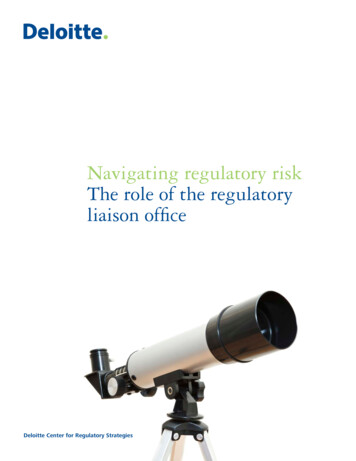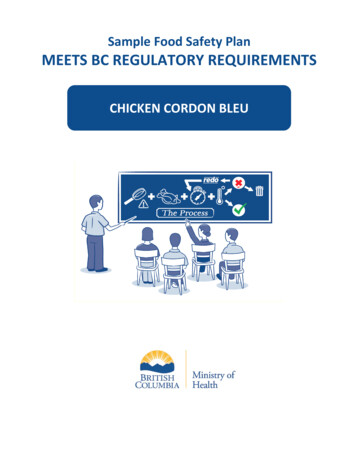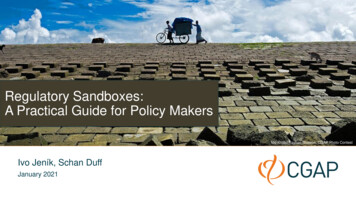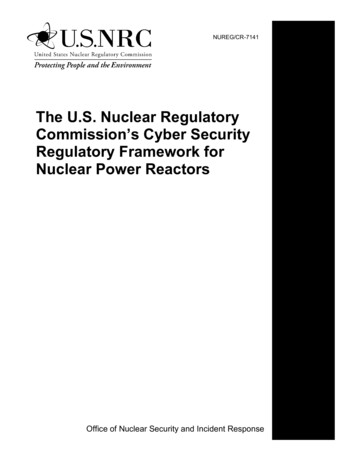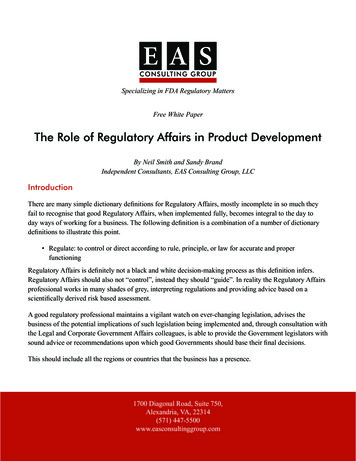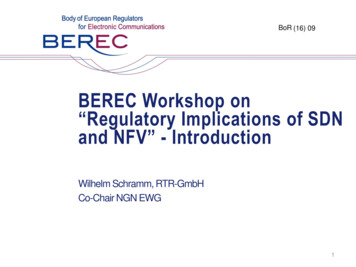
Transcription
BoR (16) 09BEREC Workshop on“Regulatory Implications of SDNand NFV” - IntroductionWilhelm Schramm, RTR-GmbHCo-Chair NGN EWG1
Background and goal In recent years the electronic communications sector together with the IT sector started to work very intensely on two new fundamental technologicaldevelopments: Software-Defined Networking (SDN) and Network Functions Virtualisation (NFV)SDN and NFV have the potential to completely change the way how networks are built and operatedtoday andare still in a state of dynamic developments At this workshop experts in the area of SDN and NFV will present their viewon the regulatory impact that SDN and NFV will haveThe workshop will help BEREC to form it's opinion on the topic of SDN/NFVwith regard to the Review of the Regulatory Framework2
What is SDN? ONF has defined an SDN architectureThe ONF/SDN architectureconsists of 3 distinct layersThe ONF/SDN architecturehas 3 key attributes Logically centralized intelligence Programmability Abstraction3
What is NFV? (1) NFV aims to transform the waythat networks are built andoperated Evolving standard IT virtualisation technologyConsolidate many networkequipment types onto “industrystandard” high volume servers,switches andstorage Network functions areimplemented in software4
What is NFV? (2) ETSI has defined a high-levelNFV framework with 3domains: Virtualised Network Functions NFV Infrastructure and NFV Management andOrchestration A VNF is a virtualisation and software implementation of anetwork functionThe NFVI consists of thevirtualisation layer and thehardware resources5
What is the relation between SDN and NFV? NFV is highly complementary to SDN Ultimately, NFV and SDN will be subsumed into a unified software-basednetworking paradigm Network operators have the possibility to use both, SDN and NFV, and to combine SDN and NFV appropriatelySDN and NFV are in a state of dynamic developments. This includes alsohow to combine SDN and NFV (see e.g. ETSI GS NFV-EVE 005)Source: NO ETSI (2012), p. 5, NO ETSI (2014) p. 16.6
Future network based on SDN and NFV7
Benefits of SDN and NFVSDN and NFV have the following benefits:*) A new dimension of programmability, automation, and network controlEnables to build highly scalable, flexible networks Reduced equipment costs (CAPEX) and reduced power consumption (OPEX)Rapid innovationTargeted service introduction depending on geography or customer setsServices can be rapidly scaled up/down as required Optimizing network configuration and/or topology in near real time Much more efficient test and integration Further benefits*) NO ETSI NFV ISG (2012), p. 8, ONF (2012), p. 28
Regulatory implications of SDN and NFV? (1) Will SDN and NFV enable fixed network access which gives alternativenetwork operators more control over the network of the incumbentcompared to current layer 2 wholesale access products? Will SDN and NFV enable or facilitate new forms of network interconnectionbased on which data (Ethernet) connections can be set up dynamically on demand (similar to a phone call)? Will SDN and NFV enable further new forms of network access or networksharing?9
Regulatory implications of SDN and NFV? (2) Will SDN and NFV have (further) impacts on the current value chain?Which? Will SDN and NFV have an impact on the relation between OTT players andtelecommunications service providers? Which? Will SDN and NFV have further regulatory implications?10
Agenda of the workshop Presentations of 3 standard development organisations Open Networking Foundation (ONF)ETSI NFV Industry Specification GroupMEF Presentations of 3 network operators Colt, QSC and Telefonica Presentations of 3 vendors Alcatel-Lucent, Fujitsu and Hewlett Packard Panel discussion11
Thank you12
Literature (1) Athur D. Little, Bell Labs (2015), Reshaping the future with NFV and SDN.The impact of new technologies on carriers and their networks, 2015 http://sdn.ieee.org/images/pdf/adl belllabs 2015 reshapingthefuture.pdf ETSI GS NFV (2014), Network Functions Virtualisation (NFV); ArchitecturalFramework, V1.2.1, Dec. 2014 http://www.etsi.org/deliver/etsi gs/NFV/001 099/002/01.02.01 60/gs NFV002v010201p.pdf Network operators (NO) of the ETSI NFV ISG (2012), Network FunctionsVirtualisation, White Paper, October 22-24, 2012 https://portal.etsi.org/NFV/NFV White Paper.pdf13
Literature (2) Network operators (NO) of the ETSI NFV ISG (2014), Network FunctionsVirtualisation, White Paper, October 14-17, 2014 /NFV White Paper3.pdf ONF (2012), Software-Defined Networking: The New Norm for Networks,White Paper, April 13, 2012 loads/sdn-resources/whitepapers/wp-sdn-newnorm.pdf ONF (2014), OpenFlow-enabled SDN and Network Functions Virtualization,ONF Solution Brief, February 17, 2014 tion.pdf14
Ultimately, NFV and SDN will be subsumed into a unified software-based networking paradigm Network operators have the possibility to use both, SDN and NFV, and to combine SDN and NFV appropriately SDN and NFV are in a state of dynamic developments. This includes also how to combine SDN and NFV (see e.g. ETSI GS NFV-EVE 005) 6

